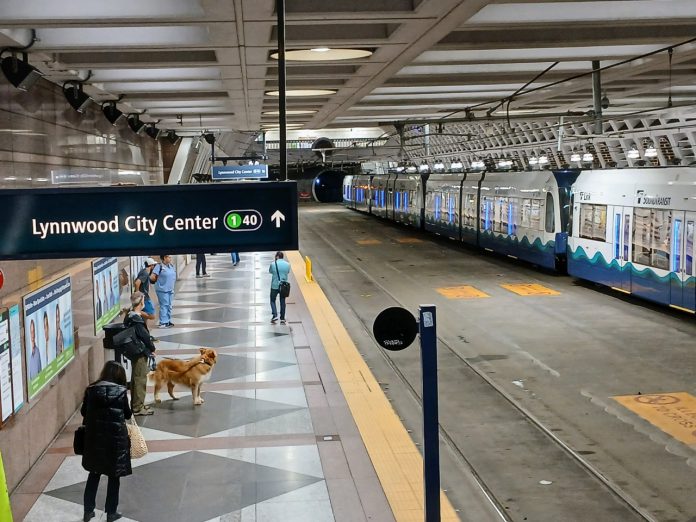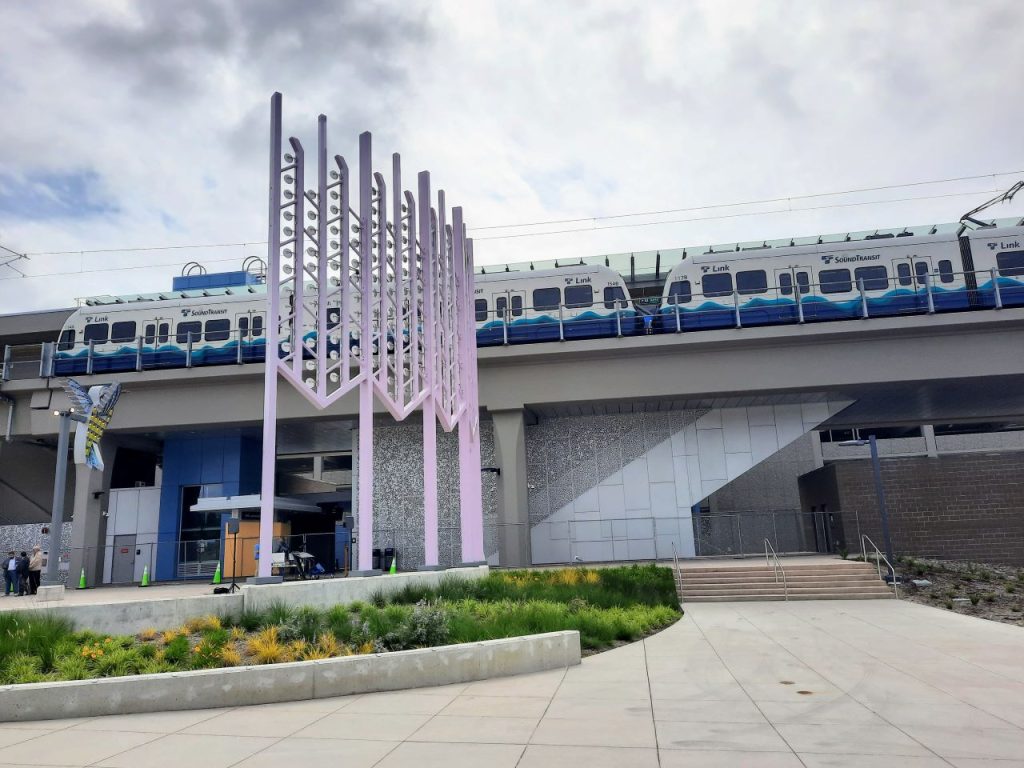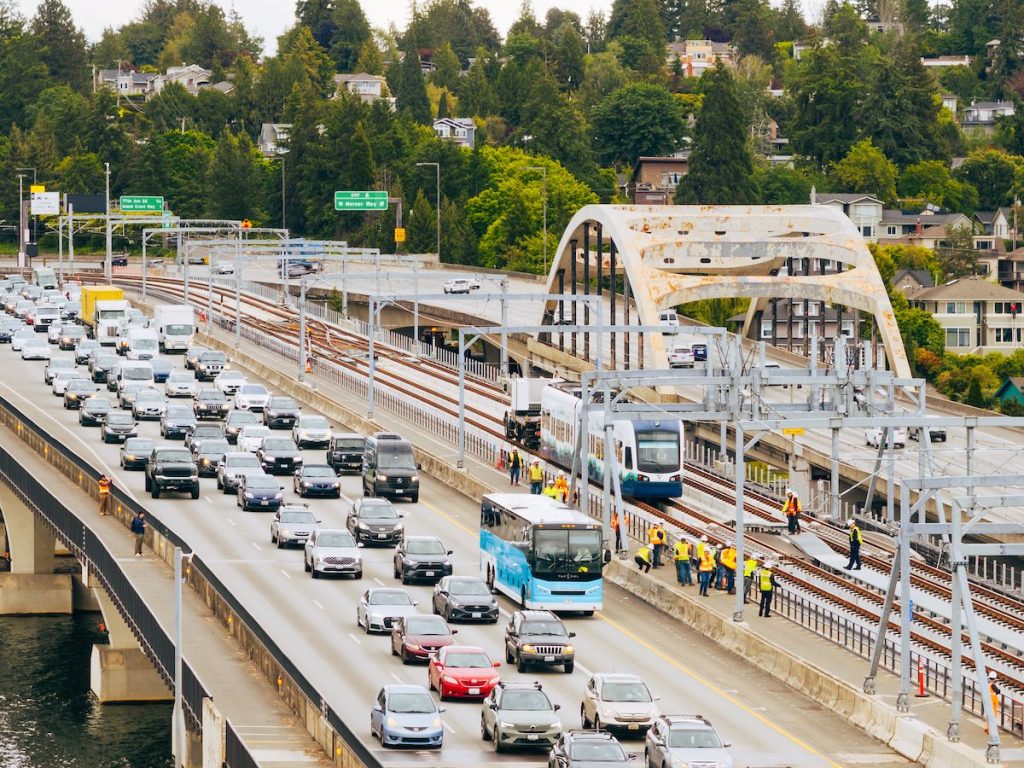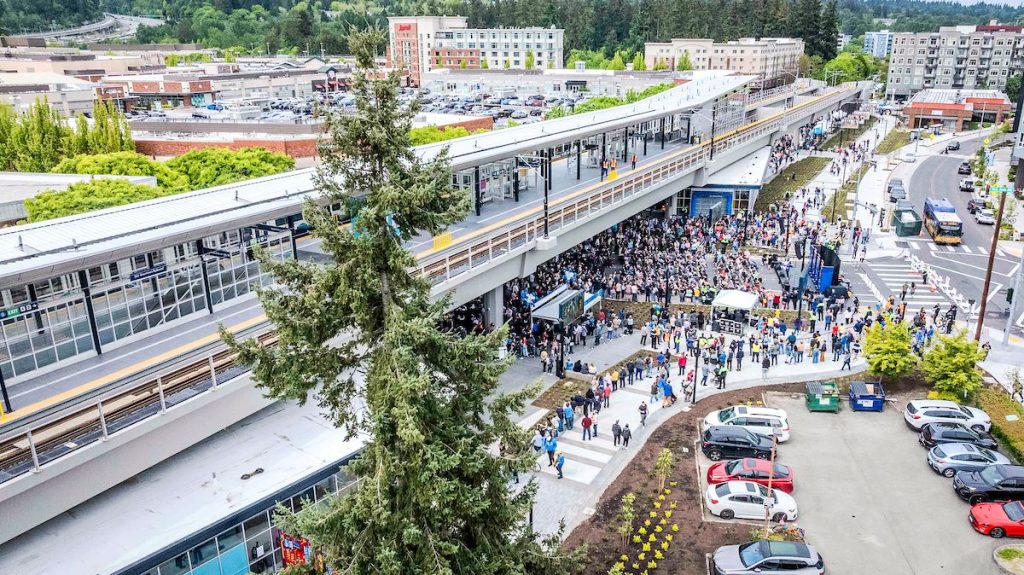
Eyes across the region are on the I-90 bridge, where Sound Transit continues to work toward the start of live wire testing on the beleaguered section of the 2 Line, the next major step toward finally connecting the rail link between Seattle and the Eastside. But Sound Transit faces additional challenges when it comes to sending trains up to Lynnwood on tracks shared by the 1 Line, a service plan that will mean trains coming through stations north of Stadium every four minutes during peak hours.
Inherited issues with the Downtown Seattle Transit Tunnel (which was built by King County Metro with buses initially in mind) and other choices that Sound Transit has made itself as it has built out the 1 and 2 Lines could prove to be barriers to reliable service. This spring, Sound Transit released a report commissioned from the engineering firm HNTB, flagging issues with consistently achieving promised headways as the system expands.
Some of those same systemic issues are likely continue to exacerbate service disruptions, likely impacting many more riders in the future, with trains coming from Federal Way and Redmond sharing the same tracks.
HNTB’s findings were first reported by Mike Lindblom at the Seattle Times in March. But Lindblom’s reporting largely focused on current service disruptions on the 1 Line, including a look at the causes and repercussions of a September 2024 incident near University of Washington Station that created a slow zone for northbound trains that lasted nearly five months. But the report flagged several major issues that could intensify as Sound Transit starts running more trains along the existing 1 Line tracks.
The Urbanist has flagged many of these issues in the past, including the potential for service disruptions to have a wider impact once the 1 and 2 Lines connect, but the HNTB report underscores the systemic nature of those vulnerabilities.
Lynnwood City Center station’s design could be a weak point for the entire system

With the 1 Line and 2 Line both set to terminate at Lynnwood City Center until at least 2037 when trains start running north toward Everett, few other stations are as critical to maintaining operations on the Sound Transit network as Lynnwood. But the report identifies the lack of a crossover track south of the station as a potential impediment to hitting promised service levels, a decision it specifically traces back to a desire to cut costs.
“While the [Lynnwood Link] extension includes additional switches and sectionalized power zones for greater single-tracking flexibility, the terminal station’s constrained environment could prove challenging for achieving desired 4-minute headways,” the report states.
A crossover track is simply a connection between the northbound and southbound tracks, infrastructure that gives Sound Transit flexibility to turn trains around and to navigate around other stalled trains. Other current or former terminus stations, including Angle Lake and Northgate, have crossover tracks in front of the station, a move that allows trains to alternate which side of the platform they arrive on. But Lynnwood only has crossover tracks behind the station, which means any train that needs to stay at the platform longer than expected, for whatever reason, impacts the ability for others to arrive and head south again.
“The current infrastructure has multiple single points of failure,” the report notes. “With a single platform used for arriving trains, a passenger incident that requires a longer-than-planned station dwell can result in cascading delays to the following trains. The disruption data provided by Sound Transit indicated that the new segments, including the Lynnwood Link, tended to experience higher failure rates in 2024.”
So far, Sound Transit has done two tests of maintaining four-minute headways, running simulated service between Lynnwood and Stadium Stations in between revenue service trains. Those tests have allowed Sound Transit to test operations along with systems like those showing arrival times at stations. But testing will really ramp up when Sound Transit enters its simulated service period after completing live wire testing.

“Sound Transit remains confident in our ability to deliver four-minute headways on the interlined section of the 1 and 2 lines when the Crosslake Connection opens next year,” Sound Transit spokesperson Henry Bendon told The Urbanist.
Lack of crossover tracks elsewhere likely to continue exacerbating service disruptions
While the location of crossover tracks in Lynnwood could add operational constraints, the lack of crossovers elsewhere in the system definitely will as the number of trains increases. Between the high-ridership segment from Northgate to Stadium, there are only two sets of crossover tracks, one south of University of Washington and one north of Westlake. With more trains, comes the potential for more disruptions: any stalled train or one stopped at a station for an extended period has the potential to create delays through the entire system, which again, means everywhere from Federal Way to Downtown Redmond.
If Sound Transit has to single track anywhere between University of Washington and Northgate, Judkins Park and Westlake, or Stadium and Westlake, headways have to be reduced to 24 minutes — or more. HNTB noted that scheduled single-tracking downtown for system integration work last January, in which Sound Transit planned for trains to arrive every 26 minutes, ultimately didn’t work due to the system’s high ridership. Trains became overloaded, increasing dwell times at stations, forcing the agency to increase headways to 30 minutes or more.

Ultimately adding additional crossover tracks will be the only long-term way to make progress on solving this issue.
“Implementing retrofits to address these gaps is complex, capital intensive, and cannot be undertaken lightly,” the report notes, recommending that Sound Transit consider options to add a set of crossover tracks in the vicinity of Symphony Station or Pioneer Square, in addition to fixes at Lynnwood City Center.
Adding crossovers directly to the platforms at either Pioneer Square or Symphony Station would be the least costly to Sound Transit, but would require taking that station out of service any time there’s an outage that requires single-tracking. With Pioneer Square’s planned proximity to a future station on the Ballard Link line, that would likely be a nonstarter for that station, but could be an option for Symphony if not for potential safety issues that come from installing crossover tracks directly at a platform.
Alternatively, Sound Transit could install crossover tracks within the reverse curves at either end of Symphony Station, a move that would still take the station out of service during single-tracking but come with fewer safety impacts.
To add a crossover track downtown while still maintaining all stations during single-tracking, Sound Transit would have to take the costly step of creating a new underground shaft between Pioneer Square and Symphony stations where a new set of tracks could go. Clearly the best option long-term, this would be the most disruptive option to construct, and building a new crossover track would ultimately create the same impacts that the track is intended to alleviate.

As of yet, Sound Transit hasn’t said whether it’s considering any of these options. “Sound Transit’s resiliency program is continuing to investigate opportunities to improve service and reliability in the near and long term – but it is too soon to identify what those projects might be,” Bendon told The Urbanist.
The HNTB report also identified major shortcomings when it comes to how Sound Transit handles service disruptions, beyond equipment issues and impediments that are inherent to the system itself.
“Inconsistent or outdated operating procedures often prolong disruptions,” the report states, noting that most service disruptions occurred in new segments of the system or in areas where employees had not been given full training. HNTB recommends that Sound Transit implement site-specific Standard Operating Procedures (SOPs) for certain “vulnerable points” in the system like Lynnwood.
Improvements like those are sure to be critical to keeping the light rail network reliable, as Sound Transit starts to oversee a light rail network that is 62 miles long next year, an increase of 138% in just three years. But with systemic barriers like a lack of crossover tracks poised to exacerbate disruptions indefinitely, it’s clear that Sound Transit will have to make some tough decisions sooner rather than later.
Ryan Packer has been writing for The Urbanist since 2015, and currently reports full-time as Contributing Editor. Their beats are transportation, land use, public space, traffic safety, and obscure community meetings. Packer has also reported for other regional outlets including BikePortland, Seattle Met, and PubliCola. They live in the Capitol Hill neighborhood of Seattle.

